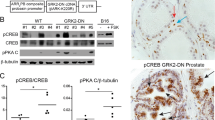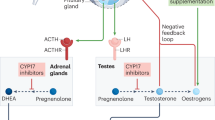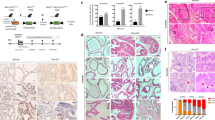Abstract
Androgen ablation is thought to exert selective pressure for the development of androgen-independent forms of prostate cancer. This study was set up to investigate the effects of surgical castration on the development of prostate adenocarcinoma (ADC) from its precursor (high-grade prostate intraepithelial neoplasia (HGPIN)) and on the occurrence of androgen-independent, poorly differentiated carcinoma (PDC) in (C57Bl/6 transgenic adenocarcinoma of mouse prostate) TRAMP mice. It was found that castration cures HGPIN and ADC and prevents their further occurrence and growth, but has no effect on PDC. This indicates that in this model, PDC is not the progression of ADC favoured by androgen ablation and that its initiating cells are different from those of HGPIN and ADC.
This is a preview of subscription content, access via your institution
Access options
Subscribe to this journal
Receive 4 print issues and online access
$259.00 per year
only $64.75 per issue
Buy this article
- Purchase on Springer Link
- Instant access to full article PDF
Prices may be subject to local taxes which are calculated during checkout





Similar content being viewed by others
References
Bostwick DG . Progression of prostatic intraepithelial neoplasia to early invasive adenocarcinoma. Eur Urol 1996; 30: 145–152.
Van der Kwast TH, Labrie F, Tetu B . Persistence of high-grade prostatic intra-epithelial neoplasia under combined androgen blockade therapy. Hum Pathol 1999; 30: 1503–1507.
Montironi R, Mazzucchelli R, Scarpelli M . Precancerous lesions and conditions of the prostate: from morphological and biological characterization to chemoprevention. Ann N Y Acad Sci 2002; 963: 169–184.
Steiner MS, Pound CR . Phase IIA clinical trial to test the efficacy and safety of Toremifene in men with high-grade prostatic intraepithelial neoplasia. Clin Prostate Cancer 2003; 2: 24–31.
Bullock MJ, Srigley JR, Klotz LH, Goldenberg SL . Pathologic effects of neoadjuvant cyproterone acetate on nonneoplastic prostate, prostatic intraepithelial neoplasia, and adenocarcinoma: a detailed analysis of radical prostatectomy specimens from a randomized trial. Am J Surg Pathol 2002; 26: 1400–1413.
Raghow S, Kuliyev E, Steakley M, Greenberg N, Steiner MS . Efficacious chemoprevention of primary prostate cancer by flutamide in an autochthonous transgenic model. Cancer Res 2000; 60: 4093–4097.
Alberts SR, Novotny PJ, Sloan JA, Danella J, Bostwick DG, Sebo TJ et al. Flutamide in men with prostatic intraepithelial neoplasia: a randomized, placebo-controlled chemoprevention trial. Am J Ther 2006; 13: 291–297.
Scattoni V, Montironi R, Mazzucchelli R, Freschi M, Nava L, Losa A et al. Pathological changes of high-grade prostatic intraepithelial neoplasia and prostate cancer after monotherapy with bicalutamide 150 mg. BJU Int 2006; 98: 54–58.
Bono AV, Mazzucchelli R, Ferrari I, Lopez-Beltran A, Galosi AB, Cheng L et al. Bicalutamide 50 mg monotherapy in patients with isolated high-grade PIN: findings in repeat biopsies at 6 months. J Clin Pathol 2007; 60: 443–446.
Banach-Petrosky W, Ouyang X, Gao H, Nader K, Ji Y, Suh N et al. Vitamin D inhibits the formation of prostatic intraepithelial neoplasia in Nkx3.1;Pten mutant mice. Clin Cancer Res 2006; 12: 5895–5901.
Narayanan BA, Narayanan NK, Pittman B, Reddy BS . Regression of mouse prostatic intraepithelial neoplasia by nonsteroidal anti-inflammatory drugs in the transgenic adenocarcinoma mouse prostate model. Clin Cancer Res 2004; 10: 7727–7737.
Gupta S, Adhami VM, Subbarayan M, MacLennan GT, Lewin JS, Hafeli UO et al. Suppression of prostate carcinogenesis by dietary supplementation of celecoxib in transgenic adenocarcinoma of the mouse prostate model. Cancer Res 2004; 64: 3334–3343.
Narayanan BA, Narayanan NK, Pttman B, Reddy BS . Adenocarcinoma of the mouse prostate growth inhibition by celecoxib: downregulation of transcription factors involved in COX-2 inhibition. Prostate 2006; 66: 257–265.
Greenberg NM, DeMayo F, Finegold MJ, Medina D, Tilley WD, Aspinall JO et al. Prostate cancer in a transgenic mouse. Proc Natl Acad Sci USA 1995; 92: 3439–3443.
Johnson MA, Hernandez I, Wei Y, Greenberg N . Isolation and characterization of mouse probasin: an androgen-regulated protein specifically expressed in the differentiated prostate. Prostate 2000; 43: 255–262.
Gingrich JR, Barrios RJ, Foster BA, Greenberg NM . Pathologic progression of autochthonous prostate cancer in the TRAMP model. Prostate Cancer Prostatic Dis 1999; 2: 70–75.
Winter SF, Cooper AB, Greenberg NM . Models of metastatic prostate cancer: a transgenic perspective. Prostate Cancer Prostatic Dis 2003; 6: 204–211.
Martiniello-Wilks R, Dane A, Mortensen E, Jeyakumar G, Wang XY, Russell PJ . Application of the transgenic adenocarcinoma mouse prostate (TRAMP) model for pre-clinical therapeutic studies. Anticancer Res 2003; 23: 2633–2642.
Kaplan-Lefko PJ, Chen TM, Ittmann MM, Barrios RJ, Ayala GE, Huss WJ et al. Pathobiology of autochthonous prostate cancer in a pre-clinical transgenic mouse model. Prostate 2003; 55: 219–237.
Young RH, Srigley JR, Amin MB, Ulbright TM, Cubilla AL . Variants of prostatic adenocarcinoma, other primary carcinomas of prostate, secondary carcinomas. In: Rosai J, Sobin LH (eds). Atlas of Tumor Pathology. Tumors of the Prostate Gland, Seminal Vesicles, Male Urethra, and Penis, vol. 28. Armed Forces Institute of Pathology: Washington, DC, 2000, pp 235–236.
McGinley JN, Knott KK, Thompson HJ . Effect of fixation and epitope retrieval on BrdU indices in mammary carcinomas. J Histochem Cytochem 2000; 48: 355–362.
Amato RJ, Logothetis CJ, Hallinan R, Ro JY, Sella A, Dexeus FH . Chemotherapy for small cell carcinoma of prostatic origin. J Urol 1992; 147: 935–937.
Ro JY, Têtu B, Ayala AG, Ordóñez NG . Small cell carcinoma of the prostate. II. Immunohistochemical and electron microscopic studies of 18 cases. Cancer 1987; 59: 977–982.
Sarma DP, Weilbaecher TG . Small-cell carcinoma of prostate. Urology 1989; 33: 332–335.
Eng MH, Charles LG, Ross BD, Chrisp CE, Pienta KJ, Greenberg NM et al. Early castration reduces prostatic carcinogenesis in transgenic mice. Urology 1999; 54: 1112–1119.
Gingrich JR, Barrios RJ, Kattan MW, Nahm HS, Finegold MJ, Greenberg NM . Androgen-independent prostate cancer progression in the TRAMP model. Cancer Res 1997; 57: 4687–4691.
Johnson MA, Iversen P, Schwier P, Corn AL, Sandusky G, Graff J et al. Castration triggers growth of previously static androgen-independent lesions in the transgenic adenocarcinoma of the mouse prostate (TRAMP) model. Prostate 2005; 62: 322–338.
Han G, Foster BA, Mistry S, Buchanan G, Harris JM, Tilley WD et al. Hormone status selects for spontaneous somatic androgen receptor variants that demonstrate specific ligand and cofactor dependent activities in autochthonous prostate cancer. J Biol Chem 2001; 276: 11204–11213.
Chmelar R, Buchanan G, Need EF, Tilley W, Greenberg NM . Androgen receptor coregulators and their involvement in the development and progression of prostate cancer. Int J Cancer 2007; 120: 719–733.
Tilley WD, Lim-Tio SS, Horsfall DJ, Aspinall JO, Marshall VR, Skinner JM . Detection of discrete androgen receptor epitopes in prostate cancer by immunostaining: measurement by color video image analysis. Cancer Res 1994; 54: 4096–4102.
Heer R, Robson CN, Shenton BK, Leung HY . The role of androgen in determining differentiation and regulation of androgen receptor expression in the human prostatic epithelium transient amplifying population. J Cell Physiol 2007; 212: 572–578.
Mirosevich J, Gao N, Gupta A, Shappell SB, Jove R, Matusik RJ . Expression and role of Foxa proteins in prostate cancer. Prostate 2006; 66: 1013–1028.
Huss WJ, Gray DR, Greenberg NM, Mohler JL, Smith GJ . Breast cancer resistance protein-mediated efflux of androgen in putative benign and malignant prostate stem cells. Cancer Res 2005; 65: 6640–6650.
Wikstrom P, Lindahl C, Bergh A . Characterization of the autochthonous transgenic adenocarcinoma of the mouse prostate (TRAMP) as a model to study effects of castration therapy. Prostate 2005; 62: 148–164.
Acknowledgements
This research was funded by GlaxoSmithKline, Italian Association for Cancer Research (AIRC), Milan, Italy; Italian Ministry for Education, University and Research PRIN projects.
Author information
Authors and Affiliations
Corresponding author
Additional information
Note: During the preparation of our revised version, a paper was published (Wendy J Huss, Danny R Grayy, Keyvan Tavakoli, Meghan E Marmillion, Lori E Durham, Mac A Johnson, Norman M Greenberg and Gary J Smith in Neoplasia 2007; 9: 938–950), substantially in agreement with our own conclusion, in which it is stated ‘poorly differentiated TRAMP tumours emerge independent from the adenocarcinomas and derive from malignantly transformed progenitor cells rather than from transdifferentiation of adenocarcinoma cells’.
Rights and permissions
About this article
Cite this article
Bono, A., Montironi, R., Pannellini, T. et al. Effects of castration on the development of prostate adenocarcinoma from its precursor HGPIN and on the occurrence of androgen-independent, poorly differentiated carcinoma in TRAMP mice. Prostate Cancer Prostatic Dis 11, 377–383 (2008). https://doi.org/10.1038/pcan.2008.13
Received:
Revised:
Accepted:
Published:
Issue Date:
DOI: https://doi.org/10.1038/pcan.2008.13



